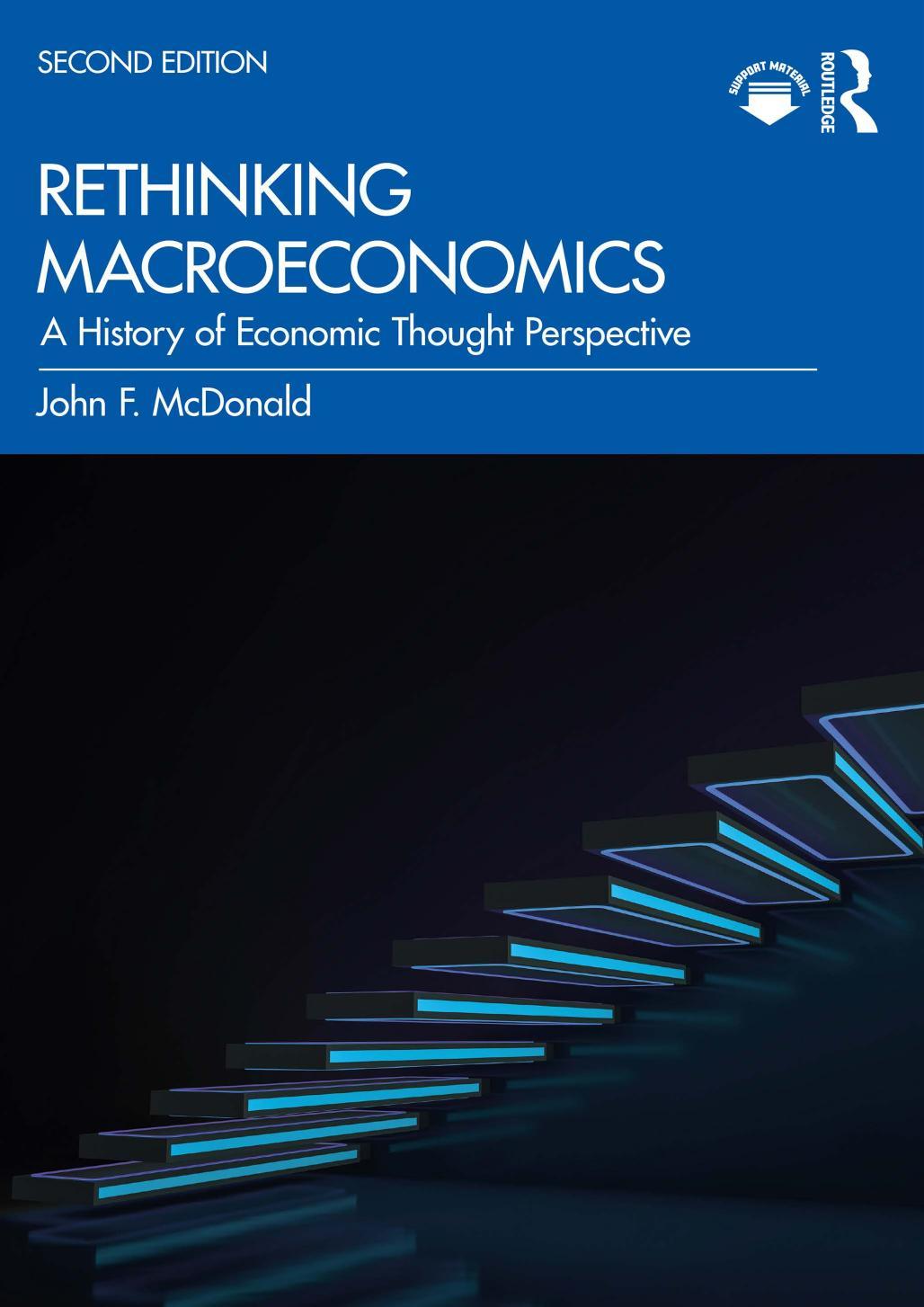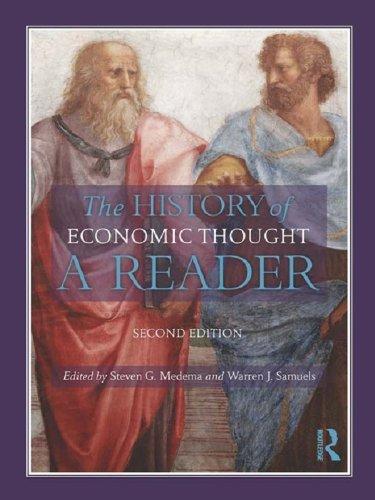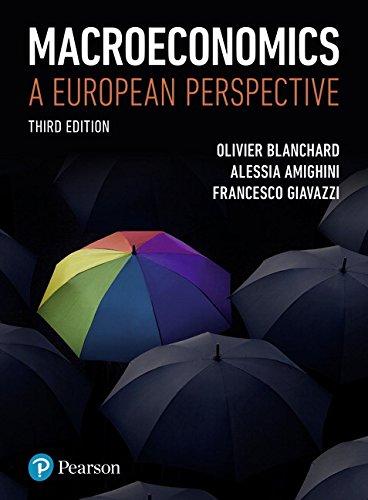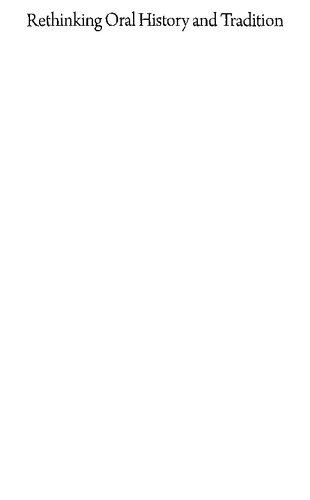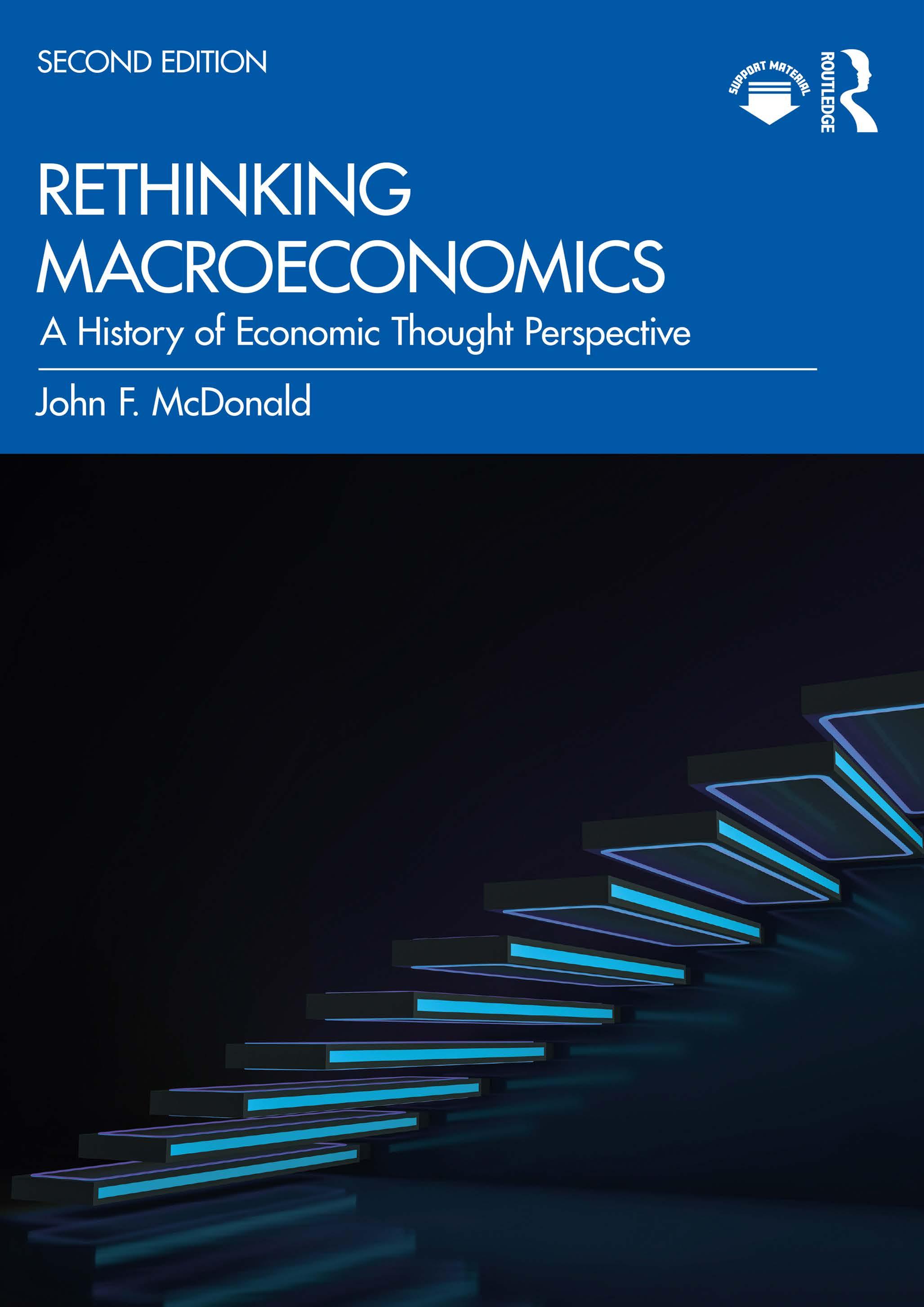Preface
This book is a revised and expanded version of Rethinking Macroeconomics: An Introduction, which was published in 2016. New features are:
■■ Addition of an international perspective by including the United Kingdom, Japan, and some nations in the Euro zone.
■■ Chapter 1 is now much expanded to provide an introduction to economics so that the book can be used as a textbook for Principles of Macroeconomics.
■■ A new chapter presents Modern Monetary Theory as an additional approach to macroeconomics.
■■ A chapter examines Japan’s recovery from World War II and its subsequent “lost decade.”
■■ Another chapter discusses the European Union and the experience with a common currency, the Euro. Data on Germany, France, Spain, and Greece are included.
■■ The chapter on the financial crisis and recession of 2008–2009 is expanded to include the United Kingdom, Germany, and Japan.
■■ Another new chapter examines the macroeconomic experience of the United States, the United Kingdom, Japan, and Germany during the pandemic year of 2020.
This book is still a text in macroeconomics that follows a teaching strategy different from all of the texts of which I am aware. Macroeconomics is a contentious field. Several different theories exist, their adherents have strongly held views, and some of the people in the field really do not like each other. My view is that the student should not be kept from this state of affairs. Rather, an educated person deserves to know about the differences that exist. Beyond knowing about the different theories, the educated person needs to be able to look at the evidence and make judgments about the various explanations that these theories offer. Students who study this book will know about the different theories and be able to figure out how the theories comport with evidence.
My work is influenced by three fundamental ideas. First, John Maynard Keynes famously said that we are all dead in the long run. What matters is what he said next. We are alive in the short run, and economics should be used to solve shortrun problems. Economics is useless if all it can do is tell us what will happen in the long run. The American artist Georgia O’Keefe said that we can get to the real essence of experience by eliminating unneeded details and concentrating on what really matters. And the economist and statesman George Shultz said that the accumulation of facts does not help us much if there is no theory to provide understanding. On the other side of the coin, spinning theories with no factual basis is worse. Theories with facts or facts with theories, these are the coins of the realm.
The book still has a simple format. The first chapter is introductory and includes background information that is needed to read the book. This chapter will be review for some students, but others will need to study the material carefully. The topics are the production possibility curve, the basics of supply and demand, macroeconomic data, international trade and the balance of payments, the creation of the money supply, and fiscal policy. The different theories are presented in the following six chapters. These chapters are followed by chapters containing empirical examinations of macroeconomic episodes in the United States, the United Kingdom, the Euro zone, and Japan. Basic macroeconomic data are presented, and a narrative is laid out for each episode. Then a comparison is made between the narrative and the implications of each of the theories. Each of these empirical chapters ends with a judgment as to which theory seems to work best. The judgment is based on a “preponderance of the evidence,” not on the basis of “beyond a reasonable doubt.”
Teaching is required at every step. Each of the theories must be taught and learned. Students must gain familiarity with the data sources. Then they must be taught how to look at the data with a discerning eye and how to compose a narrative of what they see. I have supplied a narrative for each episode, but these narratives are in print – not carved in stone. And students must learn how to compare the facts from the narrative with the implications of the theories. Furthermore, the instructor is free to present some other episode from another country (and maybe omit one from the book). Once the students get with the program, the instructor has this flexibility. Indeed, the instructor could assign the students the task of assembling data, composing the narrative, and judging the theories for episodes not in the book. The Instructor’s Manual includes more suggestions for exercises and some exam questions.
I imagine that this book is suitable for a course of one academic term, with about two weeks for Chapter 1 and one week for each theory and each episode. The book is best suited for undergraduate students who have had an introductory course in economics or for graduate students in fields other than economics (e.g., MBA students). The book is relatively short, so it could be supplemental reading for a semester course in macroeconomics at the intermediate level.
I wish to thank those who have made this book possible. Natalie Tomlinson, my editor at Routledge, is at the head of this list. She suggested that the book should include material about other advanced nations besides the United States. And the title of the book is her idea. Chloe James and Emma Morley took the manuscript through the publication process. Next, I thank the reviewers of the book proposal
for their encouragement, especially the one who used the term “engaging writing.” I admit that, for better or worse, some of the writing is based on how I talk in class. Then there are thanks to my family “pod.” The book was written during the fall of 2020, a time of pandemic. I divided my time between teaching online, writing the book, and helping with the grandchildren. My wife, Glena, served as quartermaster, and food was delivered. Our daughter Elizabeth taught our grandson Elliot kindergarten at home, while Glena and I occupied our granddaughter Madeleine, age 3. And our son-in-law Charles worked from home in the basement. We all observed the recommended quarantine procedures so it all could work safely.
John F. McDonald
Philadelphia February 2021
to economics
Introduction
How can economics be defined? The standard definition begins with the notion that a society has limited resources that can be used for different purposes. Economics studies the choices for the use of those resources made by individuals, firms, governments, and society as a whole. Furthermore, economics focuses on the incentives that influence and reconcile those choices.
The part of economics that studies the choices made by individual people and businesses is called microeconomics. Those choices are added up to be the study of markets. The choices made by governments in the use of resources and in the regulation of markets are also the purview of microeconomics. Furthermore, economists contend that those choices are rational. Choices are made in response to incentives – monetary and otherwise. Microeconomics looks at the economy from the “bottom up.”
Macroeconomics is the study of the behavior of the economy as a whole. The idea is to understand the determinants of aggregate economic activity – the total output of goods and services and its main components, unemployment, inflation, and other indicators of aggregate economic activity. Macroeconomics is concerned with identifying policies that will improve the performance of the aggregate economy, such as reducing the volatility of the economy and keeping unemployment and inflation low. The subject is of obvious importance. Macroeconomics looks at the economy from the “top down.”
At this time (2021), the field of macroeconomics continues to undergo quite a lot of rethinking. Several schools of thought are, or least their adherents think they are, in contention to provide the best model for future thinking and policy action. In fact, contending schools of thought have been in the pot for decades, but the financial crisis and deep recession that started in 2007 and 2008 have brought the pot to a boil. What is an educated person to think, and do? The editorial pages and the semi-popular books on economics present the views of various economists and other experts, and the voracious reader can come away very confused. The person
who reads only the authors who represent one particular school of thought does not come away confused but, I would submit, does not come away educated.
The purposes of this book are to introduce you to the field of economics in general, and then to explore these contending schools of thought in the context of those facts that Secretary Schulz mentioned. At the same time, we shall be mindful that details are confusing, and that emphasis is needed to get at the real meaning of things. The schools of thought – Keynesian, Monetarist, and others – are described first. Then macroeconomic data for several time periods for the United States and a few other nations are presented. The last step is to assess the ability of each of the schools of thought to provide a reasonable explanation for what happened in each of those time periods. It may be that one school of thought is not “best” for all of the selected time periods. Indeed, real-world experience produced a rethinking of macroeconomics in the 1920s, the 1930s, the 1970s, the 1980s, and in the past few years. The various schools of thought were born out of the seeming failure of the prevailing macroeconomic theory. The educated person deserves to know what’s what and who’s who of all of this.
The most important example of this rethinking was conducted by J. M. Keynes in the General Theory of Employment, Interest, and Money (1936). The General Theory was written during the depths of the Great Depression of the early 1930s, and it can be regarded as the founding document for the field of macroeconomics. It is a product of its time, to be sure. Indeed, Keynes believed that useful economics is a product of its time. His purpose was to develop a theory that explained the obvious facts that the capitalist economies of the day were not generating anything close to full employment, and that this state of affairs had existed for several years. The economic theory of the time, which Keynes called the postulates of classical economics and dismissed in a few pages, was not capable of providing an explanation of these overwhelming facts.
Progress in economic analysis and policy making (and in other scientific fields as well) proceeds by
■■ being confronted with facts that cannot be explained by the existing theories,
■■ devising new theoretical explanations (or modifying the existing theories) so as to account for the new facts,
■■ working out the implications of the new theory,
■■ conducting tests of the new theory, and
■■ using the new theory to make economic policy in those situations with the conditions contemplated in the new theory.
The highest accolades in economics often are conferred on those who devise the new theory that turns out to be successful. Keynes provided the new theory but devoted very little space in the General Theory to empirical testing or policy recommendations. Indeed, the lack of details pertaining to economic policy is striking and perhaps is surprising, given that much macroeconomic policy now has been based on Keynesian principles for decades. But Keynes’s purpose in his book was to develop a new theory that could explain, to the satisfaction of his fellow economists, the overwhelming facts of the depression in the private economy. Here is a famous quote attributed to Keynes: “When the facts change, I change my mind.
What do you do sir?” Unfortunately, there is no evidence that he ever said this, but it sounds like something he would have said.
As I neared the completion of the first version of this book, a new book by the economist Dani Rodrik (2015) arrived. The title of the book, Economics Rules, means that economics as a discipline operates with certain rules. The rules include (2015, p. 213):
■■ Economics is a collection of models; cherish their diversity.
■■ It’s a model, not the model.
■■ Make your model simple enough to isolate specific causes and how they work, but not so simple that it leaves out key interactions among causes.
■■ Unrealistic assumptions are OK; unrealistic critical assumptions are not OK.
■■ To map a model to the real world, you need explicit empirical diagnostics, which is more craft than science.
A summary of Rodrik’s view is that economics expands horizontally by adding more models that can be used to understand particular situations. There is no one model that explains all situations. Models that fail in certain situations are not discarded but rather saved and still used to understand other situations to which they do apply. This book is written in this spirit. Macroeconomics consists of a collection of models that keeps expanding because the world and the questions we ask keep changing.
This chapter introduces you to the background information and tools that you need to read the rest of the book.
The big questions
The big questions that must be answered in any economy are:
■■ what goods and services to produce,
■■ how to produce those goods and services, and
■■ for whom shall the goods and services be produced?
Any economy is somehow organized to allocate its scarce resources to produce goods and services for people.
How can we judge how well the society has accomplished these basic tasks? One method is to determine the efficiency with which the resources have been used. Could more have been produced with the given resources? Could more of one good have been produced without a reduction in the production of anything else? Or would an increase in the output of one good have required a reduction in the output of another good? If the answer to the first two questions is “yes,” then the society has not been as efficient as possible.
A second method for judging the outcome of an economy is the fairness with which the goods and services are distributed to the people (the “for whom” question). If the society has, in principle, enough resources to provide for the basic needs of all, does it? Beyond that, does the society generate a highly unequal
distribution of goods and services even if the basic needs of all are met? Does such an unequal outcome meet with the approval of most people? The issue of distribution has been argued by economists, philosophers, and everyone else since the beginning of civilization. The economist falls back on a simple rule that mirrors the rule for production efficiency. If the well-being of one person can be improved without reducing the well-being of any other person, then make the change indicated, especially if that one person is poor compared to the majority of society.
In a nutshell, the economic way of thinking, always in an economist’s head, is the understanding that a choice is a tradeoff – something must be given up to get something else. An efficient economy, as defined earlier, is one in which this rule applies. In order to have more of one good, you must give up the opportunity to have the same amount of some other good. What must be given up is called the opportunity cost. More of one good requires giving up the opportunity to have some of the other good. Note that opportunity cost occurs at the “margin” – one more of this means less of that. So how are those choices made? As noted, economists believe that choices are made in response to incentives. Rational choice involves reckoning the opportunity cost of an action in comparison to its benefits. For example, a person goes shopping for food. The price of steak is $9.00 a pound. The decision to buy the pound of steak means that, ultimately, the person has $9.00 less to spend on other items. That is what a price means, after all. Is a pound of steak worth the price to the shopper? Only that person can answer the question, of course. How does production occur? How are the “what” and “how” questions answered? An economy uses what are called the basic “factors of production” to produce goods and services. Those factors are:
■■ land
■■ labor (both quantity and quality)
■■ capital (plants, office buildings, machinery, etc.)
■■ technology
■■ entrepreneurship (the capacity to recognize what goods and services to produce and the ability to organize the inputs to get the job done)
The quality of labor is otherwise known as “human” capital – knowledge, experience, and expertise. College students are considered by economists to be investing in human capital (at least some of the time). But experience on the job also counts as valuable human capital.
Basic concepts I: production possibilities
A simple diagram captures the “what” and “how” questions. Consider Figure 1.1. On the vertical axis we measure units of an all-purpose consumption good, and the horizontal axis is used to chart units of investment goods. Investment goods are things such as plants, equipment, and houses that are used to produce consumption goods in the future. The diagram depicts consumption and investment, because these are basic concepts in macroeconomics. In essence, Figure 1.1 is showing the options available for the production of goods and services for use now versus the
capacity to produce goods and services later – the now-versus-later choice. The curve is called the production possibilities curve
The diagram is drawn for given supplies of the basic factors of production – land, labor, capital, technology, and entrepreneurship. Any point on the curve shows the maximum amount of consumption goods that can be produced given the indicated amount of investment goods – hence, production possibilities. The curve is drawn with a negative slope because more of one good means that less of the other good can be produced given the resources available. Each and every point on the curve is based on an allocation of the basic factors of production. Suppose one more unit of investment goods is contemplated as shown in Figure 1.1. The curve shows how much consumption goods must be given up – the opportunity cost of investment goods. As the slope is the “rise over the run” of the curve (in this case, the “rise” is negative), the opportunity cost of investment is the slope of the production possibility curve. Furthermore, that increase in investment at the expense of consumption will require some shifting of the basic factors of production from one use to another – a different allocation of resources. For example, some farmers will become construction workers.
The points on the production possibilities curve represent efficient allocations of resources, because more of one good can come only with a reduction in the other good. On the other hand, a point inside the curve (such as point A) is a point of inefficient use of resources, because more output of one or both goods can be achieved by moving to the curve (as shown by the arrow). And a point outside the curve (such as point B) cannot be reached with the available resources. Point B can be reached only if there is some increase in the resources available to the society. How can an increase happen? Increases can occur by an increase in the labor force, by an increase in capital through use of resources to produce investment goods, or by an improvement in the technology of production. But none of that can happen immediately.
There is one more feature of the production possibilities curve to point out. The curve has been drawn bowed out – not a straight line. As shown in Figure 1.1, the
FIGURE 1.1 Production Possibilities
curve says that the opportunity cost of investment goods gets larger as the amount of investment is greater. At the smaller amount of investment goods, the amount of consumption given up is a small amount. But at the larger amount of investment goods, the amount of consumption given up at the margin is larger. Why? The basic idea is that resources vary in their ability to produce the two goods. At the smaller amount of investment, an increase in investment output would be accomplished by moving resources that are adept at producing investment goods away from consumption goods. That would be an efficient way to get it done. However, if the amount of investment already is large, getting more investment goods production requires moving resources out of consumption goods production that are less adept at the new task. But one does the best that is possible to be efficient.
Basic concepts II: supply and demand
This book makes use of a basic economic theory apparatus, supply and demand. Economic analysis usually is done with diagrams (or equations), and this book is no exception. So here is an explanation of the fundamental tool that is used. A few simple equations also are used and explained along the way.
Start with the supply and demand diagram that depicts the market for an individual consumer good (see Figure 1.2). The horizontal axis measures the quantity of the good demanded or supplied, and the vertical axis measures the price of the item. The demand curve slopes downward because households buy more when the price is lower. The supply curve slopes upward because suppliers provide more quantity at a higher price. The market is assumed to be competitive, i.e., there are many suppliers and demanders who take the market price as given, suppliers are producing the same product, and the features of the product are well known to all in the market. The market price is set by the impersonal forces of
competition. Figure 1.2 depicts two supply and two demand curves. These curves are explained next.
The basic model of supply and demand is based on rather extreme assumptions; actors in the market take the market price as given, all suppliers produce the same product, and all actors in the market have complete knowledge of the product and the market. Some actual markets satisfy, or come very close to satisfying, these assumptions. For example, the markets for basic agricultural products (corn, wheat, etc.) are considered to be competitive. However, the usefulness of the model has been found to extend to other markets. For example, while the various brands of automobiles are different in some respects, a simple supply-and-demand model of total auto sales can be used to study overall trends. The market is no longer dominated by a very small number of firms, so the market can for some purposes be treated as competitive. The course in microeconomics includes extensive examination of different types of markets that range from competitive to monopoly (single seller).
The market price in a competitive market is determined by the intersection of the supply and demand curves. At this price, the quantity supplied is just equal to the quantity demanded. If the price somehow gets set at a level higher than at that intersection, some suppliers are unable to sell their output and therefore will reduce the price at which they are willing to sell. This process forces other sellers to lower the price and, fortunately, more is demanded as the price comes down. The process stops – you know where. What happens if the price starts out below the intersection of supply and demand? You say it….
Now comes the hard part, the part that confounds many students upon their first encounter with economics. Standing behind the supply and demand curves are several factors that determine the position of the curves. The demand curve represents the amount demanders plan to purchase at alternative prices, holding all factors other than price constant. In particular, the demand curve is drawn for a given number of households with given incomes and tastes and preferences for goods that they may purchase. In addition, the prices of other goods are assumed to be constant. What if the number of households increases? More of the good will be purchased at each possible price – the entire demand curve shifts up. We say that demand has increased. The result of the shift in demand is that the quantity purchased goes up and the price increases along the given supply curve. Figure 1.2 depicts a shift in the demand curve. The same idea applies if they change their preferences in favor of the good, and usually applies if households have an increase in their incomes. A more complex point is that, if the price of a good that is a substitute for the good in question increases, the demand curve in Figure 1.2 shifts up. And if the price of the substitute good declines, the demand curve in Figure 1.2 shifts down. If the price of hot dogs increases, the demand for hamburgers increases.
On the supply side, the supply curve is drawn for a given level of production technology, given costs of the relevant inputs (labor, materials, etc.), and a given number of (the numerous) suppliers. In addition, the “state of nature” is given; for example, bad weather interrupts production. Producers plan to offer the amounts shown by the curve at alternative prices because they can make a “normal” profit, given that these other factors are held constant. If production costs decline because technology improves or input costs decline, more will be supplied at each possible price. The entire supply curve shifts to the right. We say that supply has increased.
Figure 1.2 also depicts a shift in the supply curve. Note that an increase in supply (shift to the right) brings about a lower price and a larger quantity of the good bought and sold along a given demand curve.
The basic supply and demand apparatus facilitates what I like to call the one-thing-at-a-time rule. Economic analysis is designed to enable us to figure out what happens if one thing changes and everything else remains the same. Now the fact is that, in the real world, lots of things are changing at the same time. Figuring out what is going on in the real world is difficult. Economics says, “Let’s break all of that down into its different pieces.” That way we at least have a chance to understand what is going on. Suppose we observe that the price went up and the quantity did not change. What might have happened? We would look behind the curves. Did production costs rise? That would shift the supply curve to the left and make prices rise. If the demand curve does not move, then the supply curve shift tells the story. But what if household incomes increased as well? Then a greater quantity would be purchased at each possible price. So the combination of cost increases and household income increases can explain why the price went up and quantity was constant. It all depends on how the factors standing behind supply and demand change. Can you think of a set of reasons why price can decrease while quantity remains constant? Have fun.
The basic supply–demand diagram can be used to make one of the fundamental points of this book. Movements in the demand and/or supply curves cause changes in the quantity of output and the price. If demand increases, both output and price increase. If demand decreases, output falls and the price declines. Or, if supply increases, output rises and the price declines; and if supply decreases, output falls and the price increases. In short, changes in the position of the demand curve make output and price move in the same direction, while changes in the position of the supply curve result in output and price movements in opposite directions. This basic insight can (and will) be used to distinguish among the contending macroeconomic theories.
Basic concepts III: macroeconomic data
The purpose of the book is to confront the different macroeconomic theories with data. So what data would that be? A conventional set of macroeconomic variables exists, and it will be used here. The annual Economic Report of the President has a very useful appendix that contains the data for the United States in recent decades. The Bank of England provides macroeconomic data for the United Kingdom, and the Organisation for Economic Co-operation and Development (OECD) has data for other advanced economies.
The first variable is the measure of the total output of the economy, now called gross domestic product (GDP). This is the dollar value of the final output for a year. For example, one might think that the output of an auto company is simply the dollar value of the final output, the cars and trucks sold. But the auto company has purchased many parts from its suppliers. The final output of the auto company is the value that is added to the parts purchased from other companies and is produced by the labor and services of its plant and equipment employed in the process of turning parts into a car. Furthermore, the parts suppliers purchased materials from
firms that produce materials (steel, rubber, aluminum, etc.). The final output of a parts supplier is the value added to the purchased materials by the firm’s labor and capital services. In short, the GDP is the total of value added by the producers in the economy. Alternatively, the GDP is the total amount paid for the services of labor, existing capital equipment (including buildings), and land. In other words, the total final output must equal the income paid to these basic inputs. One bit of terminology – GDP measures the dollar value of total final output produced within the confines of the borders of the nation. Previously the term used was gross national product (GNP), but a change in terminology and measurement was made to eliminate output produced in other countries by U.S. firms.
The measure of GDP we shall use is spending on final goods and services, and spending is broken down into four basic parts; these are consumption, gross investment, government purchases of goods and services, and net exports of goods and services (exports minus imports). Consumption consists of purchases of goods and services by households for current use. It does include some items that will last for some years (clothing, shoes, stoves, home computers, and so on) as well as food, haircuts, and electricity. Consumption can be broken down into nondurable and durable goods. Housing consumption is reckoned as rent paid for the services of housing units – which means that the GDP includes the implicit rent that a homeowner is paying to himself or herself. Households use their disposable personal income (income after taxes) to purchase consumption goods and services. They also save out of disposable personal income.
Gross investment is the amount spent by private producers for new plants (including office buildings, stores, factories, etc.), equipment (computers, assembly lines, and so on), and inventories of goods to be sold later. Gross investment also includes amounts spent to build new housing units. Some gross investment simply replaces plants, equipment, and houses that have worn out, and investment that adds to the stocks of capital is called net investment. The difference between gross and net investment is the amount spent to cover the depreciation of existing capital. Inventories of goods are also an important component of gross investment. Changes in inventories can be signals for economic upturn or downturn. An increase in inventories often means that business is slowing down – goods are not being sold but are instead stacking up in the warehouse. Or an increase in inventories can mean that an increase in business is expected. A reduction in inventories can mean that business is picking up, to be followed by an increase in production and employment, or it can mean that firms are cutting back on production because business is expected to decline. (Some variables are just not clear indicators.) Firms use profits (after taxes), increases in ownership shares (e.g., issuing more stock in the case of corporations), and borrowing to pay for investment. Profits earned by corporations are also used to pay dividends to the shareholders (the owners of the firm). Profits earned by businesses that are not corporations (i.e., partnerships and sole proprietorships) are used for investment or income for the owners of the firm as well.
Government purchases of goods and services count as part of the GDP. Government purchases many things from private producers – from paper clips to B-1B bombers and office buildings. Some government purchases are actually forms of capital (B-1B bombers and office buildings), but government purchases are not normally broken down into current and capital spending. And, very importantly, much of government spending consists of wages paid to government employees. It
is assumed that the wages paid are equal to the value of the services provided by those employees. Government collects taxes to spend on its purchases, but also borrows money to finance its spending.
The fourth major category of GDP is net exports. Exports of goods and services to foreign countries obviously are part of domestic production. But why do we subtract imports? The answer is that the other three categories of GDP include spending on imports. Household consumption spending includes clothing made abroad, investment spending includes computers made abroad, and government spending includes subway cars made abroad. The subtraction of total imports adjusts for all of these types of imports.
So far, GDP and its components are measured in dollar terms, but if prices are rising (or falling), then changes in GDP from one year to the next give a misleading picture of the change in output in a “real” sense. Indeed, if all prices rise by 5% but actual outputs do not change, and the economy has not produced any more goods and services, the total dollars say otherwise. This issue is addressed by the construction of a price index. Actually, there are several price indexes, and the most popular one is called the Consumer Price Index (CPI). This variable measures the dollar cost of a given basket of consumer goods, and then over time turns the measures into an index. The price index used for GDP is called the GDP price deflator. The GDP price deflator in the early 2010s was based on the cost of the relevant basket of goods in 2009, so the value of the index for 2009 is 100. The values for this price index for some recent years are:
These figures mean that overall prices were higher in 2010 compared to 2009 by 1.22 percent. Prices were higher in 2013 compared to 2009 by 6.73 percent. And, for example, prices increased by 2.06 percent between 2010 and 2011. This is figured as (103.31 – 101.22) divided by 101.22. The modern price indexes change the basket of goods included in the index as spending patterns change. Another piece of notation that we will use is:
GDP = PY
where P is the price index (divided by 100) and Y is GDP corrected for the price level, i.e., Y = GDP/P. For example, using 2009 as the base year, the real output of the economy for 2009 was $14,418 billion. GDP for 2013 was $16,768 billion, but Y = $16,768/1.0673 = $15,711 billion in real terms.
The basic equation that you should now commit to memory is:
Y = C + I + G + X
where X stands for net exports, the other terms are obvious, and the components of GDP are stated in real terms (i.e., corrected for the price level).
In our notation, GDP is output stated in nominal terms, i.e., not corrected for inflation. And Y is output stated in real terms, i.e., corrected for inflation. Real output will also be called real GDP. The distinction between nominal and real amounts will be used repeatedly
Various measures are used to assess the extent to which the economy is falling short of its full output potential. The most popular measure is the unemployment rate. This variable is measured monthly and is based on a survey of households in which people are asked:
Are you employed?
Are you not working?
If you are not working, do you want to work?
Are you actively looking for work? (Various methods of looking for work are indicated.)
The total labor force is defined as those currently working plus those actively looking for work. The unemployment rate is the number of people actively looking for work divided by the total labor force. The unemployment rate so defined is a very useful indicator of the state of the macro economy, but at times it is deficient. What about people who want to work, but gave up looking because they were having no success at landing a job (or even getting an interview)? For this reason, these days we also look at the labor-force participation rate, which measures the percentage of the population aged 16 years and older that is included in the total labor force. A decline in the labor-force participation rate may mean that some people have simply given up looking for work, although it can also mean that people are retiring because they no longer need to work. Also, the unemployment rate does not measure the employed workers who are working on a part-time basis but would prefer to be working full time. The survey tracks part-time and fulltime workers. Wage rates are another measure of the labor market that is included in our macroeconomic “dashboard.” We will make the distinction between nominal wages and real wages (corrected for inflation).
Financial measures are also included in the standard set of macroeconomic variables. We keep track of interest rates, the payment at which lenders lend and borrowers borrow. Basic interest rates, such as the home mortgage rate and the rate on overnight loans between banks (called the federal funds rate), are reported in the press. But financial instruments produce yields for investors, and those yields are figured differently for different types of instruments. The yield of a certificate of deposit at a bank is simply the interest paid each month. Bonds pay a coupon every six months. Suppose you bought a new bond one year ago for $10,000 with a coupon rate of 3 percent. You receive $150 every six months. However, if the market value of the bond falls to $9,500, then you have a net yield of minus $200
